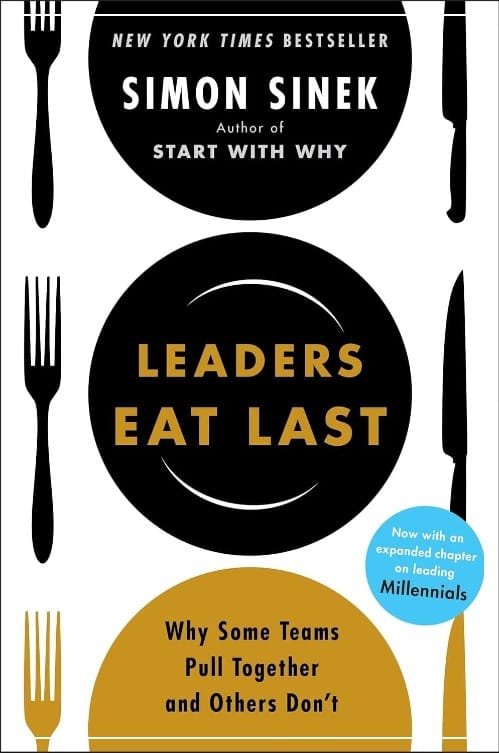Leaders Eat Last: Creating a Culture of Trust and Leadership that Inspires
Discover the leadership principles from Leaders Eat Last by Simon Sinek, focusing on empathy, trust, and servant leadership. Learn how creating a Circle of Safety and prioritizing team well-being can transform organizations and inspire loyalty.

In a world where leadership is often equated with power and authority, Leaders Eat Last by Simon Sinek shifts the focus to empathy, trust, and servant leadership. Published in 2014, the book has since become a guiding framework for leaders who wish to create thriving, successful teams by prioritizing the well-being of their people.
Drawing on examples from the military, business, and biology, Sinek argues that effective leaders create environments where individuals feel safe, valued, and empowered. This article explores the key themes and insights from Leaders Eat Last, supported by references to other leadership literature and external studies on organizational behavior.
Table of Contents
- About the Author: Simon Sinek
- Overview of Leaders Eat Last
- Key Concepts from Leaders Eat Last
- Real-World Applications of Leadership
- External Studies Supporting Sinek’s Ideas
- Conclusion: Leaders Who Serve Build Stronger Teams
About the Author: Simon Sinek
Simon Sinek is a British-American author, motivational speaker, and organizational consultant. He is best known for his first book, Start With Why, which popularized the concept of identifying and communicating purpose as the foundation of successful leadership. Sinek’s work focuses on human behavior, leadership, and organizational culture, aiming to inspire leaders to create environments that foster trust, cooperation, and shared vision.
Book Reference:
Sinek, S. (2014). Leaders Eat Last: Why Some Teams Pull Together and Others Don’t. New York: Portfolio/Penguin.
Leaders Eat Last
Overview of Leaders Eat Last
In Leaders Eat Last, Sinek explores the idea that the most effective leaders put the needs of their people ahead of their own. This concept is rooted in a practice observed in the military, where officers ensure their soldiers eat before they do. The metaphor highlights the role of leadership as one of service, sacrifice, and empathy. By creating an environment where individuals feel safe and valued, leaders inspire loyalty, cooperation, and collective success.
Leadership is not about being in charge. It is about taking care of those in your charge.
Sinek draws on both scientific research and real-world examples, ranging from the biology of leadership to historical anecdotes about great leaders. The book also delves into the dangers of leadership styles that prioritize profits or short-term gains over people, pointing to the damage that such approaches can do to organizational culture and long-term success.
Key Concepts from Leaders Eat Last
The Circle of Safety
The Circle of Safety is one of the most important concepts in Leaders Eat Last, serving as a metaphor for creating a secure environment where employees feel protected and valued. Sinek uses the analogy of primitive tribes that formed circles to protect themselves from external threats like predators or other tribes. Similarly, leaders today must create an internal environment where their people feel safe from external pressures (competition, market fluctuations) and internal threats (toxic coworkers, micromanagement).
When employees feel secure within the Circle of Safety, they are more likely to:
- Collaborate Freely: Without fear of punishment or internal competition, individuals are more willing to share ideas and support one another, leading to greater innovation and teamwork.
- Take Risks: A psychologically safe environment encourages employees to take calculated risks, try new things, and fail without fear of being ostracized. This risk-taking is essential for growth and progress within an organization.
- Feel Loyal and Engaged: When people feel that their leaders truly care about their well-being, they are more loyal to the organization and more committed to its mission.
Book Reference: Sinek, S. Leaders Eat Last, Chapter 3
External Study: A study by Edmondson (1999), published in The Harvard Business Review, confirmed that psychological safety is one of the most important factors in high-performing teams. When individuals feel safe in their environment, they’re more willing to engage in the kind of open communication and collaboration that drives success.
Real-World Example:
Southwest Airlines is often cited as an organization that exemplifies the Circle of Safety concept. Under former CEO Herb Kelleher, the company placed a strong emphasis on employee well-being. Kelleher famously stated, “The business of business is people,” ensuring that employees came first, even before customers. This employee-first mentality fostered loyalty, high engagement, and consistent performance.
Read More to Learn how to make this a habit:

The Biology of Leadership
Sinek goes beyond the metaphor of leadership and delves into the biology of leadership—how our evolutionary biology affects how we interact in groups. Humans are hardwired to seek connection, cooperation, and community. The chemicals that drive this behavior (dopamine, serotonin, oxytocin, and cortisol) also play a crucial role in leadership dynamics.
- Dopamine: This neurotransmitter is associated with achievement and reward. Leaders who focus solely on short-term results often tap into this chemical by driving their teams toward specific goals, but an over-reliance on dopamine can lead to burnout, as it rewards individual performance over collective success.
- Serotonin: This chemical fosters feelings of pride and status, which are critical for building respect within teams. Leaders who provide recognition and create a sense of belonging help boost serotonin levels, enhancing the feeling of community.
- Oxytocin: Known as the “bonding” hormone, oxytocin is responsible for creating trust, empathy, and social bonding. Leaders who prioritize team well-being, show vulnerability, and foster open communication trigger oxytocin release, which in turn strengthens relationships within the team.
- Cortisol: This is the stress hormone that prepares us for “fight or flight.” In toxic environments, leaders who instill fear and uncertainty elevate cortisol levels, leading to stress, anxiety, and even burnout. Sinek’s focus on creating a Circle of Safety helps minimize cortisol levels by fostering trust and reducing unnecessary stress.
External Reference: A research article published in Frontiers in Psychology (2015) discussed the impact of oxytocin in the workplace. It found that higher oxytocin levels were linked to increased collaboration, trust, and performance in teams. This supports Sinek’s argument that trust-building through oxytocin-inducing behaviors is essential for effective leadership.
Real-World Example:
Google’s Project Aristotle, which analyzed hundreds of Google’s teams, found that the most successful teams were those that shared psychological safety, trust, and mutual respect—qualities directly linked to serotonin and oxytocin production. These biological responses were foundational in ensuring that team members felt comfortable taking risks and being open with each other.
The Importance of Empathy and Trust
In Leaders Eat Last, Sinek repeatedly emphasizes that empathy is the most essential quality a leader can possess. Empathy allows leaders to understand the emotions, challenges, and needs of their team members, enabling them to provide the support necessary for both personal and organizational growth.
Leaders who exhibit high levels of empathy:
- Improve Employee Engagement: Employees are more likely to be engaged and productive when they feel understood and supported by their leaders. A leader’s empathy can bridge the gap between team members’ personal lives and their professional responsibilities.
- Resolve Conflicts: Empathetic leaders can effectively mediate conflicts by understanding both sides, finding common ground, and facilitating constructive communication.
- Increase Retention: Employees are more likely to remain loyal to organizations where they feel emotionally supported by their leaders.
External Study: Research by Wong & Laschinger (2013), published in the Journal of Nursing Management, found that empathetic leadership is strongly correlated with job satisfaction and employee retention. Employees who feel emotionally supported by their leaders report higher engagement and are more likely to stay with their organization long-term.
Book Reference: Sinek, S. Leaders Eat Last, Chapter 8
Real-World Example:
Starbucks CEO Howard Schultz is often cited as an example of an empathetic leader. Schultz famously ensured that Starbucks employees (referred to as “partners”) receive healthcare benefits and stock options, even for part-time workers. His leadership philosophy is rooted in the belief that caring for employees fosters loyalty and drives the company’s long-term success. Schultz has repeatedly demonstrated empathy, both in his public statements and internal company policies, creating an organization where employees feel valued and supported.
Leaders as Servants
Servant leadership is at the heart of Sinek’s message in Leaders Eat Last. Leaders are most effective when they view their role as one of service to their team members. This approach flips the traditional leadership hierarchy, where leaders are at the top, and instead places leaders at the bottom, supporting the people they lead.

Servant leaders focus on:
- Empowering Others: They enable their teams to make decisions and take ownership of their roles. By providing support and resources, they create autonomous, capable individuals.
- Prioritizing Well-Being: Servant leaders ensure that the physical, emotional, and mental health of their team members comes first. They foster environments where team members feel safe and valued, leading to long-term organizational health.
- Leading by Example: Rather than demanding respect or loyalty, servant leaders earn it by being hands-on, transparent, and aligned with the values they expect from their teams.
Book Reference: Sinek, S. Leaders Eat Last, Chapter 10
External Reference: A study published in The Leadership Quarterly (2000) found that servant leadership directly correlates with employee satisfaction, organizational commitment, and productivity.
Real-World Example:
One notable servant leader is David Marquet, a former U.S. Navy submarine captain, who implemented a servant leadership model on the USS Santa Fe. Marquet empowered his crew by pushing decision-making authority down the chain of command, allowing sailors to take ownership of their roles. This shift transformed the submarine from one of the worst-performing in the fleet to one of the best. Marquet’s experience is documented in his book Turn the Ship Around!.
Real-World Applications of Leadership
The principles outlined in Leaders Eat Last have real-world applications across various industries, from business to the military. Many organizations, including Google and the U.S. Marines, have implemented leadership strategies that align with Sinek’s vision of creating a Circle of Safety and prioritizing empathy and trust.
For example, Google has emphasized the importance of psychological safety within teams, a concept directly related to Sinek’s Circle of Safety. By creating an environment where employees feel safe to take risks and voice their ideas without fear of retribution, Google has fostered a culture of innovation and collaboration.
External Study:
A 2012 study on Google’s Project Aristotle found that psychological safety was the number one predictor of team success.
External Studies Supporting Sinek’s Ideas
- Psychological Safety and Team Performance: Research from The Harvard Business Review highlights the importance of psychological safety in driving team performance. Teams that feel psychologically safe are more likely to take risks and share innovative ideas, leading to greater success (Edmondson, A. 1999) .
- The Impact of Empathy in Leadership: A study in the Journal of Business Ethics found that empathetic leaders foster a more positive work environment and improve employee engagement, trust, and productivity (Wong, C. A., & Laschinger, H. K. S., 2013) .
- Servant Leadership and Organizational Success: Research published in The Leadership Quarterly supports the idea that servant leadership, where leaders prioritize the needs of their team, leads to higher employee satisfaction and overall organizational performance .

Leaders Who Serve Build Stronger Teams
Simon Sinek’s Leaders Eat Last offers a profound rethinking of leadership, emphasizing trust, empathy, and service. The book challenges the traditional view of leadership as authority and power and instead advocates for leaders who prioritize the well-being of their teams.
Sinek’s message is clear: Leaders who serve build trust, loyalty, and cooperation. By fostering environments where people feel safe, valued, and empowered, these leaders create organizations that are not only more successful but also more humane and fulfilling places to work. Whether in the military, business, or education, the principles outlined in Leaders Eat Last provide a roadmap for creating high-performing teams that thrive on trust and collaboration.
For anyone in a leadership role—or aspiring to be in one—Leaders Eat Last is an essential read that provides practical guidance and inspiring lessons on what it means to truly lead.




